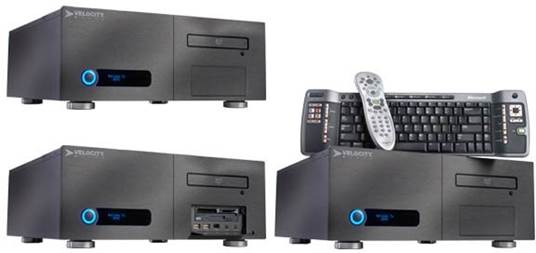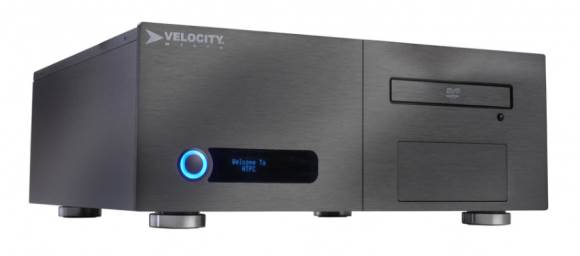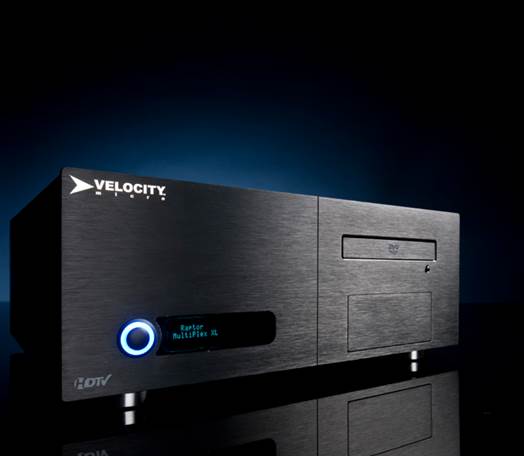It’s hard to talk about Velocity Micro's
new Multiplex machine without thinking back more than 15 years ago, to the
earliest days of "PC-TVs" and “PC Theaters."
Back in the late 1990s, vendors such as
Compaq and Gateway were pushing Pentium ll-based PCs capable of watching DVDs,
displaying electronic programming guides, and browsing the Internet, along with
other futuristic capabilities, on gigantic 36-inch CRT televisions (we say that
both literally and sarcastically).
In comparison to those early pioneers of
living room PCs, the Velocity Micro Multiplex is like a starship dropping out
of warp speed while you look on from a covered wagon trying to get over Donner Pass
without having to eat your fellow travelers.

The
Multiplex is a traditional HTPC, but fully capable of playing Big Picture Steam
games, too.
The Multiplex chassis harkens back to those
early PC-TVs, but rather than sporting a 266MHz Pentium II, a whopping 2GB hard
drive, 32MB of RAM, and an analog TV tuner, the Multiplex is pretty much
state-of-the-art: liquid-cooled Core i7-3770K clocked up to 4.3GHz, 16GB of
DDR3/2000, a GeForce GTX 680, 240GB SSD, and 3.6TB of RAID 5 storage. Besides
Gigabit and 802.11n, and the Blu-ray drive, Velocity Micro opted for a Ceton
quad-channel Cable CARD tuner to help fill that massive RAID 5 array.
That RAID array, for the record, is made up
of three 2TB WD Caviar Black drives. If one drive fails, you won’t lose it all
- we're just not so sure we'd care if we lost it, though. Since the Multiplex
is intended to quietly sit in the living room sucking up television through the
Ceton card, a drive failure wiping out, say, every episode of Glee or The
Walking Dead, wouldn't be as bad as losing 2TB of your family videos and pics.
Frankly, we think that a straight 6TB JBOD array would be just fine on a PVR
box, but if you do intend to store your memories on the machine, the RAID 5 is
warranted.

Performance of the box was in line with our
expectations. Obviously, up against our zero-point system’s Hexa-Core and
dual-GPU setup, it’s no contest. But against HTPC/gaming boxes like Digital
Storm's Bolt and Falcon Northwest’s Tiki, it’s pretty much a tie, as all three
feature overclocked 3770K parts and GeForce GTX 680 cards. Of course, you might
wonder if it’s fair to compare the Multiplex against those much smaller HTPC
machines. That's a good question. Both the Tiki and Bolt are more likely to be
used as simple SFF gaming boxes in your office, or in your living room as
"Steam Boxes” running Big Picture mode. Recording terabytes of TV isn’t
likely to be high on the list of their usage scenarios.
That s actually where the Multiplex comes
in. It's far more traditional-HTPC shaped and sized for the PVR chores, yet has
plenty of firepower to run games at 1080p resolutions. Our one complaint might
be that it’s a tad loud for pure PVR duties. If you’re watching, say, a Michael
Bay flick, you’d never hear the fan and drive noise, but if you’re trying to
catch the nuanced acting in, um, Jane Eyre on Blu-ray, you could find those
sounds distracting. This won’t be an issue in gaming, of course, but it's worth
noting.

Pricing for the rig is fair. At $3,200 it’s
a full grand cheaper than the Falcon Tiki we reviewed last September. The Tiki
did, however, pack a pair of 512GB SSDs, which adds up, but then the Multiplex
has three drives plus a CableCARD tuner.
Overall, the Multiplex brings a lot to the
table if you’re still living in a cable world - we’re just not sure how many of
us there are in today's post-cable environment.
|
Specifications
§ Processor:
Intel Core i7-3770K(a4.3GHz
§ Mobo:
Asus P8Z77-V Pro Thunderbolt
§ RAM:
16GB DDR3/2000
§ Video
Card: GeForce GTX 680
§ Sound
Card: Onboard
§ Storage:
240GB Intel SSD, three 2TB WD Caviar Black drives in RAID 5
§ Optical:
Blu-ray combo drive WH14N540
§ Case/PSU:
Custom / Corsair TX850
§ Price:
$3,200
§
Website: www.velocitymicro.com
|